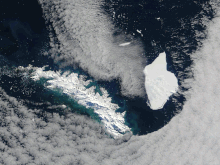Iceberg A-38

The A-38 was a large iceberg that split from the Filchner-Ronne Ice Shelf in Antarctica in 1998. The iceberg was more than 144 km long and 48 km wide, the largest iceberg that had been observed in a decade.[1]
Split of A-38B
By October 22, 1998, A-38B had started to break off the original iceberg. The pieces drifted about 1,500 nautical miles (2,800 km) north to their present location around South Georgia Island in the South Atlantic. On April 12, 2004, the A-38B iceberg was about 25 nautical miles (46 km) long. The next time MODIS flew over the iceberg on April 15, A-38B had broken in half. By April 17 and April 18, the eastern half of the iceberg had moved quickly north and turned west. The left half of the iceberg seemed to stay in place. Another section of the A-38 iceberg, A-39D, was covered in melt water ponds as it drifted past South Georgia Island in late January 2004—the height of the summer in the Southern Hemisphere.[1]
References
- ^ a b NASA (April 24, 2004). "The A38-B Iceberg Splits". Retrieved 24 April 2014.
